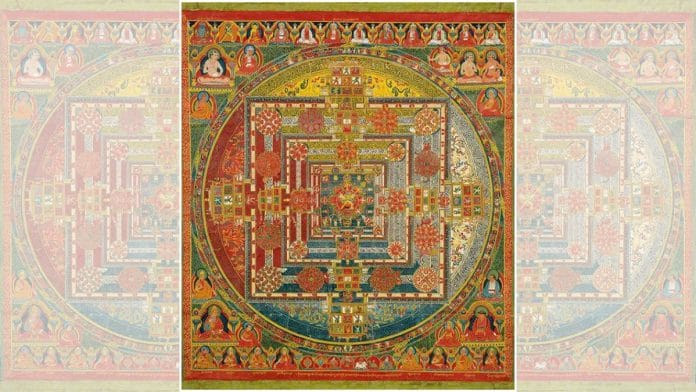New Delhi: When Buddhism was declining in Tibet in the early 11th century, a Tibetan translator, Naktso Lotsawa, turned to India for help. He invited prominent Bengali Buddhist scholar Atisa Dipankara Shrijnana to help revive the religion. The meeting changed the trajectory of Buddhism in Tibet. During his time in the neighbouring country, Atisa introduced and disseminated the Kalachakra Tantra or wheel of time—a complex text which focuses on the concept of time and its cycles.
“It has since become a prominent practice within Tibetan Buddhism,” said scholar and translator Niraj Kumar at the National Museum’s monthly lecture series titled Kalachakra Tantra: Capsule of Nalanda Tradition on 23 July.
Kalachakra Tantra was the last major tantric Buddhist text to emerge from India. Its mandalas, iconography, and metaphysical concepts continue to inform contemporary visual culture.
“Rich in visual symbolism and cosmological diagrams, it has profoundly influenced the art and ritual practices of Buddhism across Tibet, Mongolia, and parts of East Asia,” said National Museum’s Director (Conservation) Shilpa Raturi while introducing Kumar.
During his hour-long lecture, Kumar explored the text’s vision of a universal algorithm that governs the processes of decay, death and dissolution across the physical, biological and symbolic realms.
The history of Buddhism has been divided into three stages, Theravada, Mahayana and Vajrayana, he explained. They deal with ethical practice, liberation, and linguistic traditions.
“Kalachakra transcends these three stages in Buddhist history. It was in fact the fourth and last stage in the evolution of Buddhist philosophy in India and its language is mathematics,” he said.
Also read: Goddesses, scarecrows and circuses—20 new Madhvi Parekh paintings on display at DAG
Historical writing
Kalachakra Tantra is considered a king of Tantra and has been composed in one of the toughest meters of Sanskrit poetry—Sragdharā meter comprising 84 syllables in one stanza.
Even Kalidasa could dare to write only a few introductory verses in this meter, but this whole text, 1047 verses, is written in Sragdharā meter, claimed Kumar, who studied it for the last decade. He’s currently working on a five-book series about the text.
“I’m happy to explore this tantra afresh and offer it to the next generation who have to carry the burden of building a global Shambhala,” he said. Sambhala is a mythical kingdom believed to be a land of enlightenment, peace and wisdom in Tibetan Buddhism.
But the text is more than just religious expositions. It is a historical piece of writing wherein a city like Baghdad, founded in 762 CE, has been mentioned twice. This is the first Indian text to have engaged with Islamic philosophy in detail, he added.
Interestingly, Vimalaprabha, a commentary on the Kalachakra Tantra, was inscribed on the UNESCO Memory of the World Register in 2011. This text offers details on astrology, astronomy and Indian philosophy.
Kumar said the oldest copy of the manuscript of Kalachakra Tantra, a palm leaf manuscript, was found in Northeast India.
Also read: Odia literature was limited to palm leaves. Print became its tool of resistance & revival
Epitome of Nalanda
Kumar argued that despite its composition in the early 11th century, Kalachakra Tantra emerged from the Nalanda tradition of Buddhism.
“Kalachakra Tantra is the epitome of Nalanda,” he said.
In public imagination, Nalanda University was a place teeming with teachers, students and libraries. But it wasn’t the number of students or buildings that made Nalanda University famous. It was the tradition of knowledge based on a secular ontology, he said.
Many scholars have described Nalanda with different interpretations, such as na alam dadati iti Nalanda (where there is no end to offering wisdom. That is Nalanda).
“But I find it more appropriate to call it Nalanda as Nal plus Anand. Nal is hollow lotus stalk and Anand is joy. The art of deriving joy from emptiness (shunyata), that is Nalanda,” said Kumar.
(Edited by Theres Sudeep)






